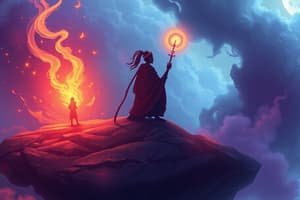Podcast
Questions and Answers
What is the primary script used to write Hindi?
What is the primary script used to write Hindi?
- Cyrillic
- Arabic
- Devanagari (correct)
- Roman
Which of the following is a dialect of Hindi?
Which of the following is a dialect of Hindi?
- Bhojpuri (correct)
- Tamil
- Punjabi
- Gujarati
From which language does Hindi primarily derive its vocabulary?
From which language does Hindi primarily derive its vocabulary?
- Spanish
- Sanskrit (correct)
- French
- Mandarin
What is the typical sentence structure of Hindi?
What is the typical sentence structure of Hindi?
Which of the following best describes Hindi's status in India?
Which of the following best describes Hindi's status in India?
Which of the following countries has significant Hindi-speaking communities?
Which of the following countries has significant Hindi-speaking communities?
Which aspect of modern usage of Hindi is increasingly noted?
Which aspect of modern usage of Hindi is increasingly noted?
What challenge does Hindi face in its national language status?
What challenge does Hindi face in its national language status?
Flashcards are hidden until you start studying
Study Notes
Overview of Hindi
- Hindi is an Indo-Aryan language primarily spoken in India.
- It is one of the 22 scheduled languages of India and an official language of the Indian government.
- Hindi belongs to the Indo-European language family.
Script
- Hindi is written in the Devanagari script, which consists of 48 characters.
- The script is phonetic, meaning it is pronounced as it is written.
Dialects
- Hindi has several dialects, including:
- Braj: Spoken in the Braj region, known for its literature and poetry.
- Awadhi: Predominantly spoken in the Awadh region of Uttar Pradesh.
- Bhojpuri: Spoken in Bihar and parts of Uttar Pradesh.
Vocabulary
- Hindi vocabulary is derived from several sources:
- Sanskrit: The primary source, contributing many words.
- Persian and Arabic: Due to historical influence during the Mughal period.
- English: Increasingly incorporated due to globalization.
Grammar
- Sentence Structure: Typically follows Subject-Object-Verb (SOV) order.
- Nouns: Gendered (masculine or feminine).
- Verbs: Conjugated based on tense, aspect, and the subject's gender and number.
Cultural Significance
- Hindi is a vehicle for rich literary traditions, encompassing poetry, prose, and drama.
- Plays a crucial role in Bollywood cinema, influencing popular culture.
Global Presence
- Hindi is spoken by over 500 million people worldwide.
- Significant Hindi-speaking communities exist in countries like Nepal, Mauritius, Fiji, and the UAE.
Language Learning
- Hindi is increasingly taught as a foreign language in many countries.
- Language learning resources include online courses, textbooks, and immersion programs.
Modern Usage
- Hindi is used in various media, including television, film, literature, and social media.
- Increasingly, Hindi incorporates modern vocabulary, including tech and internet terms.
Challenges
- Hindi's status as a national language can lead to regional tensions regarding language preference.
- Efforts to promote Hindi may sometimes conflict with the preservation of regional languages and dialects.
Overview of Hindi
- Hindi is an Indo-Aryan language predominantly spoken in India, with a rich cultural heritage.
- Recognized as one of the 22 scheduled languages in India and serves as an official language for the Indian government.
- Falls under the broader Indo-European language family, indicating its historical and linguistic roots.
Script
- The writing system for Hindi is the Devanagari script, which comprises 48 individual characters.
- Devanagari is phonetic; each character corresponds to a specific sound, making pronunciation straightforward.
Dialects
- Hindi encompasses a variety of dialects that reflect regional diversity:
- Braj: Known for its literary contributions and poetry, primarily spoken in the Braj region.
- Awadhi: Predominantly spoken in Uttar Pradesh's Awadh region, featuring unique linguistic traits.
- Bhojpuri: Commonly spoken in parts of Bihar and Uttar Pradesh, with a distinct cultural identity.
Vocabulary
- Hindi's vocabulary derives from multiple sources, enhancing its richness:
- Sanskrit: The main source, providing a vast array of lexical items and phrases.
- Persian and Arabic: Influences from the Mughal era introduced many terms into everyday usage.
- English: Globalization has led to the integration of English words and phrases, particularly in modern contexts.
Grammar
- Employs a Sentence-Object-Verb (SOV) structure, differing from many Western languages.
- Nouns in Hindi are gendered, classified as either masculine or feminine.
- Verbs are conjugated according to tense, aspect, and the grammatical gender and number of the subject.
Cultural Significance
- Acts as a conduit for literary traditions that include extensive poetry, prose, and dramatic works.
- Integral to Bollywood cinema, which significantly shapes and reflects popular culture in India.
Global Presence
- Over 500 million speakers worldwide, establishing Hindi as one of the most spoken languages globally.
- Notable Hindi-speaking communities exist in countries like Nepal, Mauritius, Fiji, and the UAE, indicating its diasporic reach.
Language Learning
- Hindi is gaining popularity as a foreign language in numerous countries, reflecting its global influence.
- Various resources are available for learners, including online courses, textbooks, and immersive experiences to facilitate learning.
Modern Usage
- Used across multiple media platforms, including television and film, literature, and social networking sites.
- The vocabulary continually evolves, accommodating contemporary terms related to technology and the internet.
Challenges
- The promotion of Hindi as a national language can lead to tensions with regional languages, affecting linguistic harmony.
- Initiatives aimed at popularizing Hindi may inadvertently threaten the preservation of regional languages and dialects, highlighting the need for a balance.
Studying That Suits You
Use AI to generate personalized quizzes and flashcards to suit your learning preferences.




